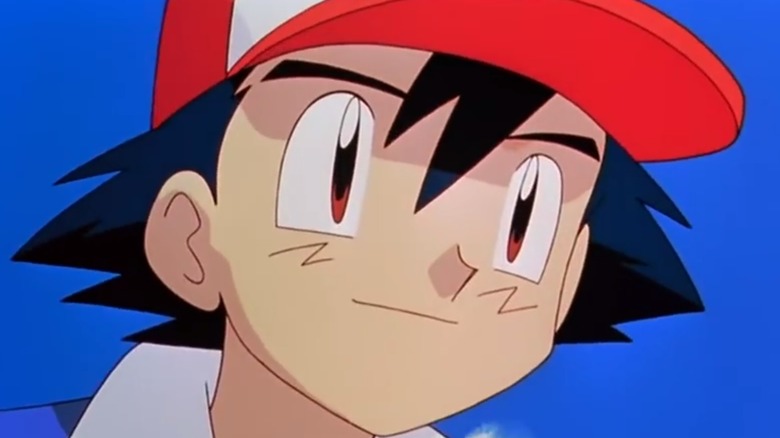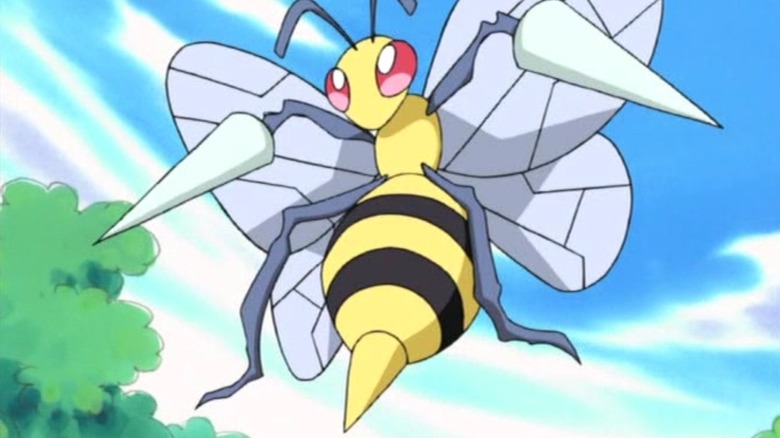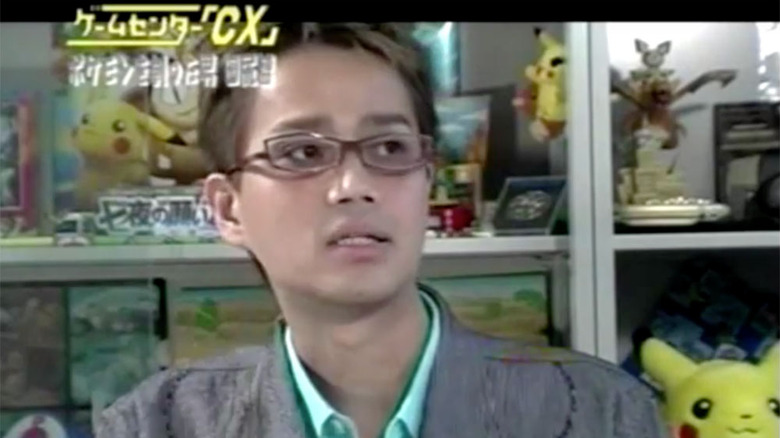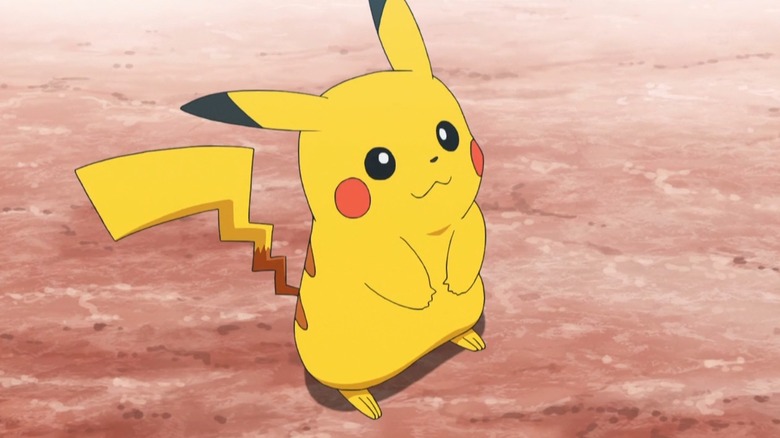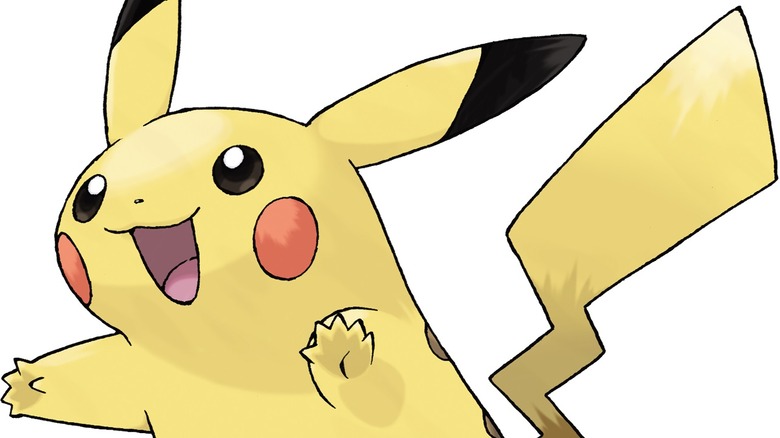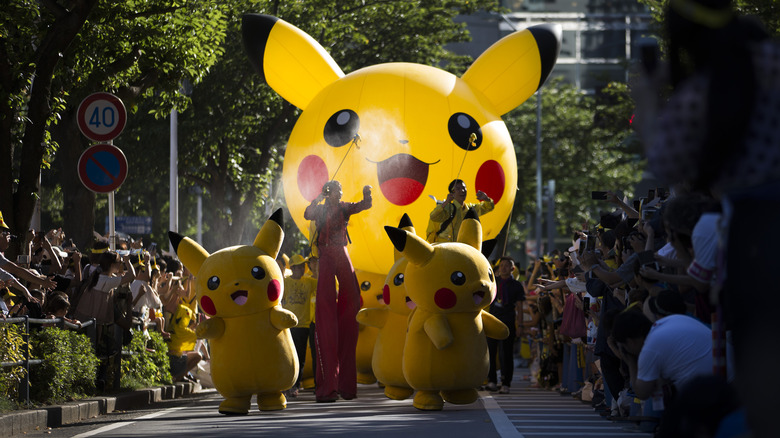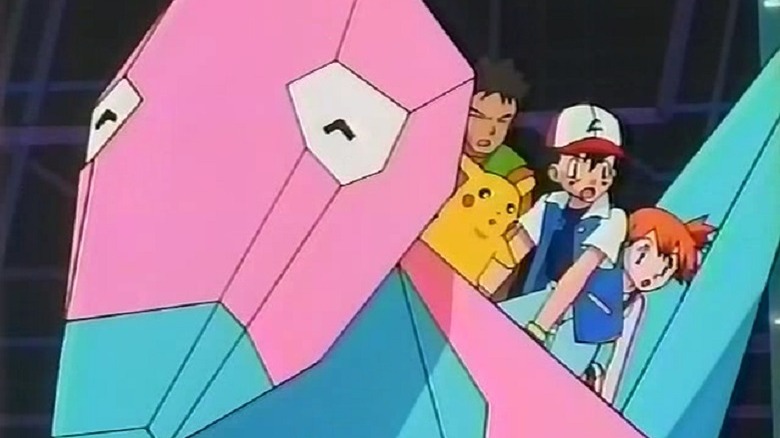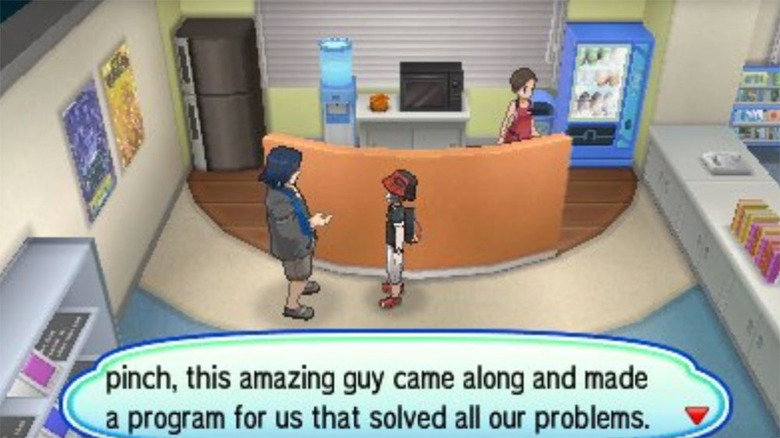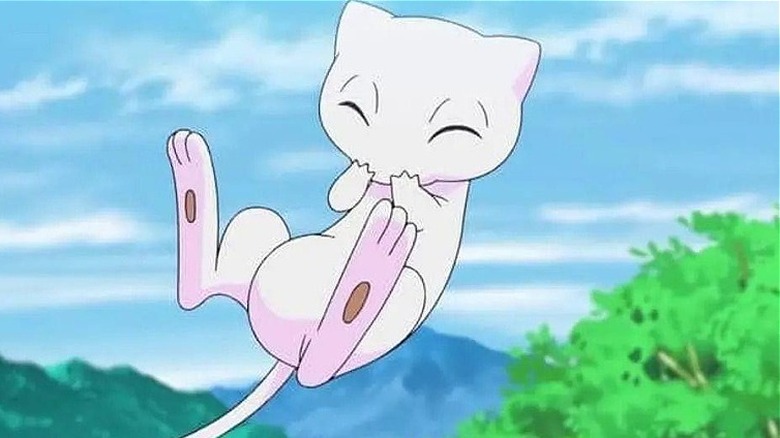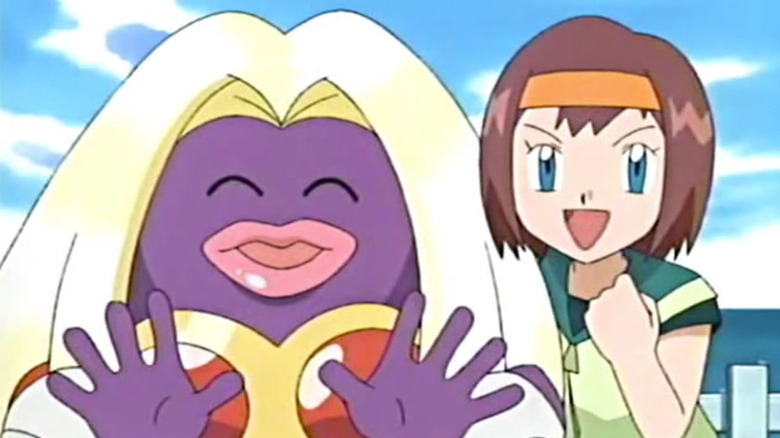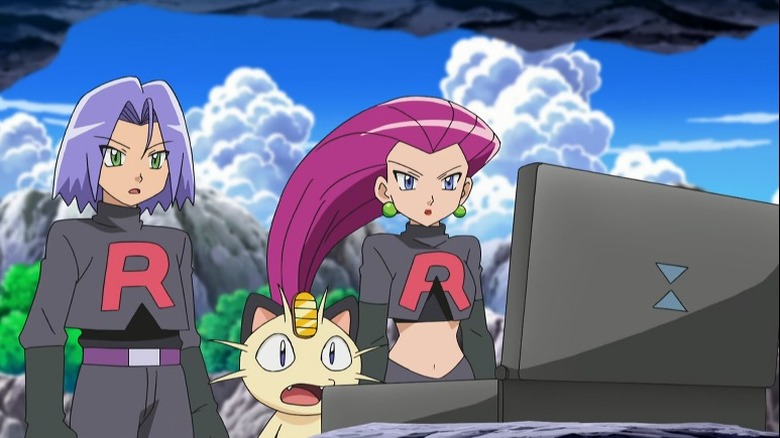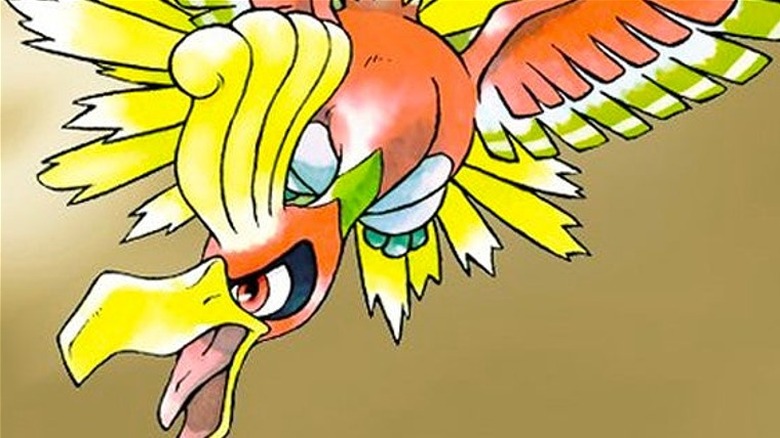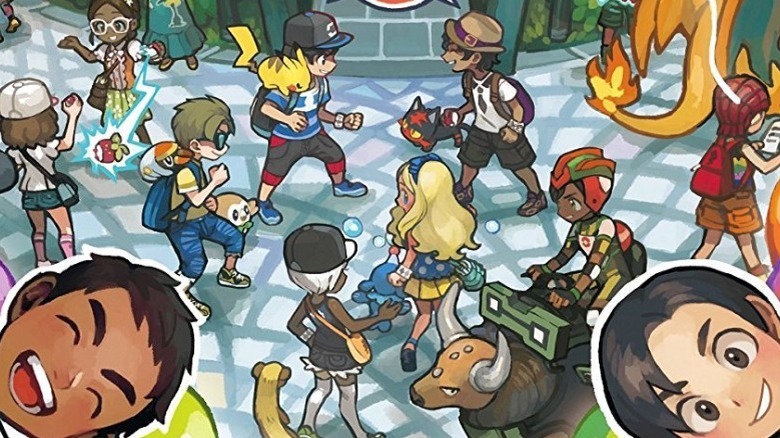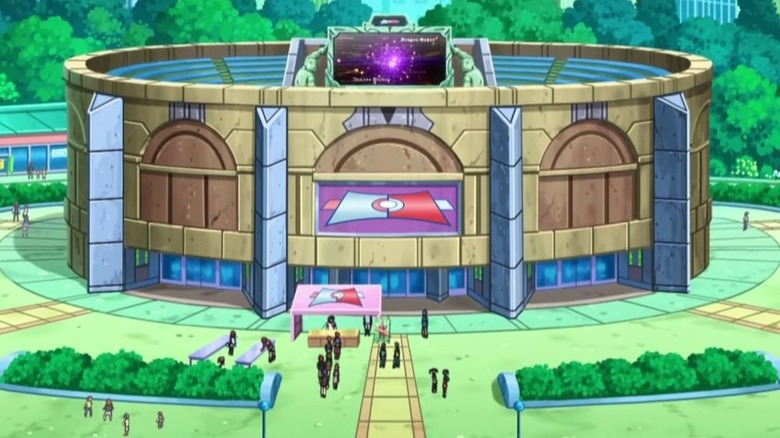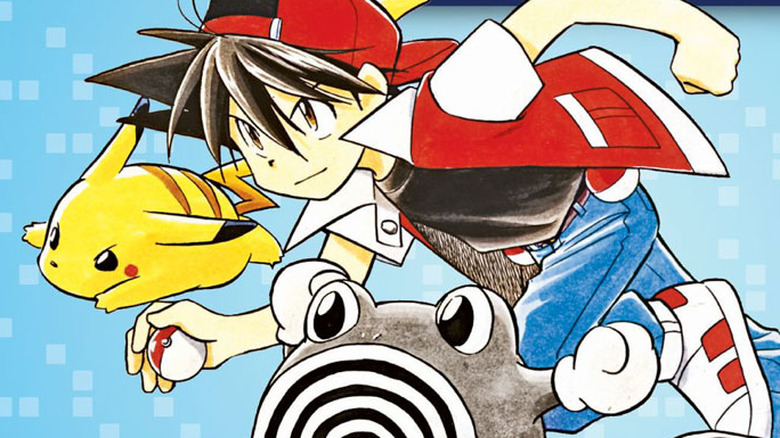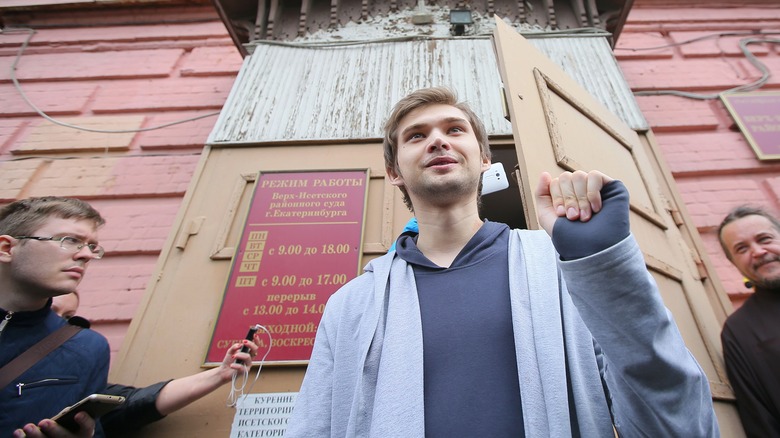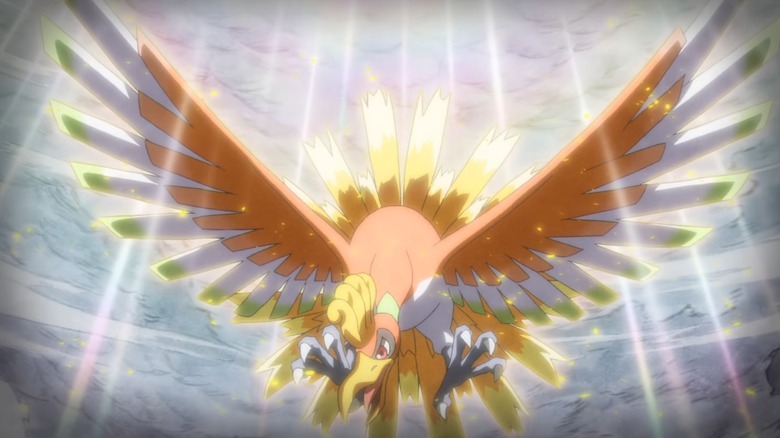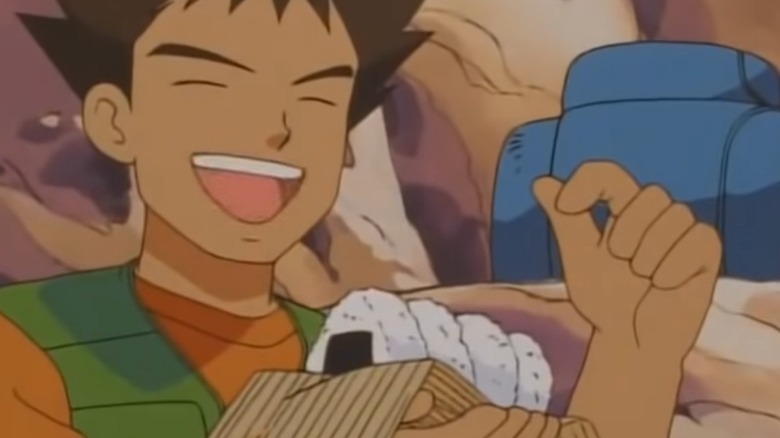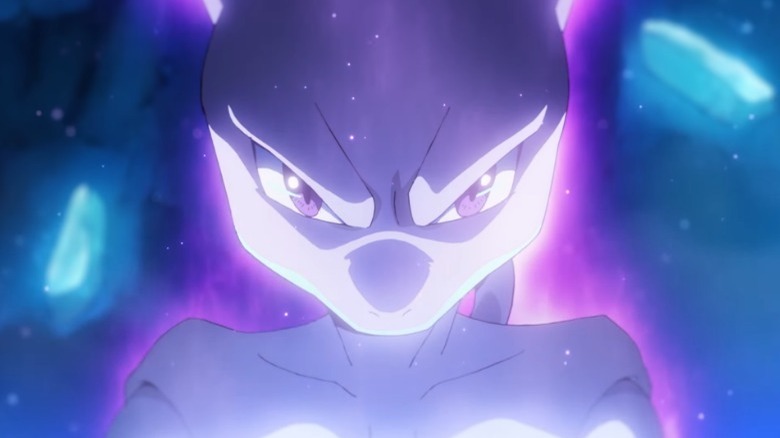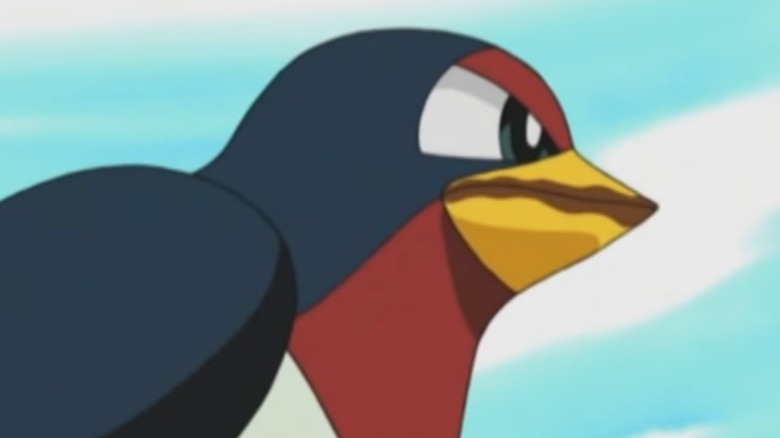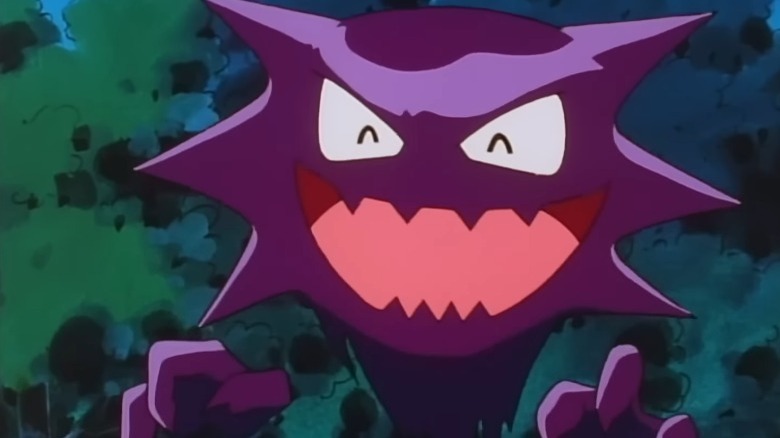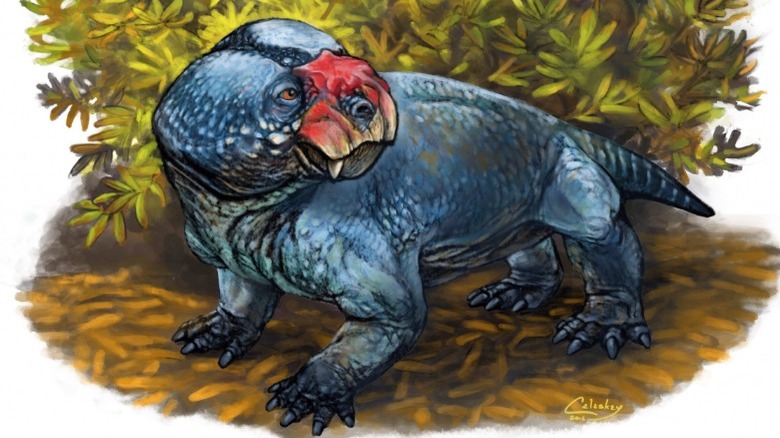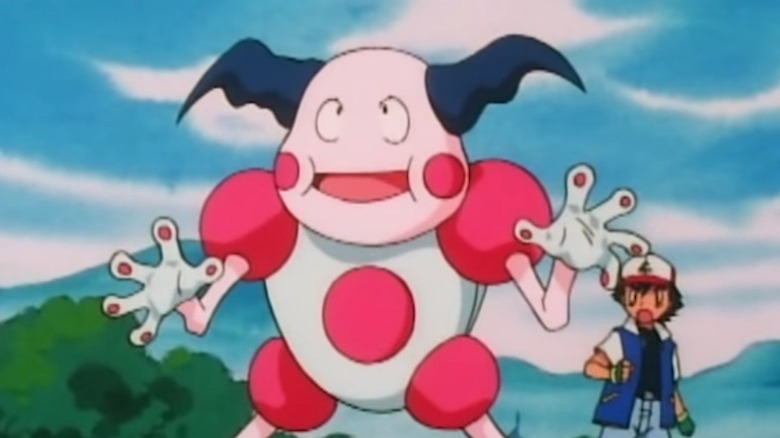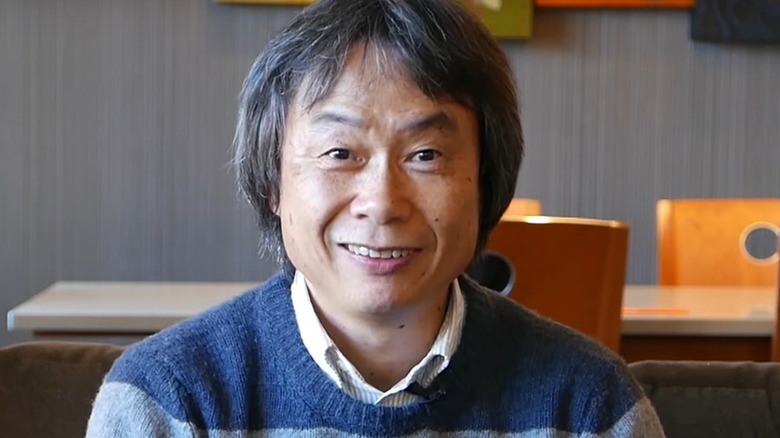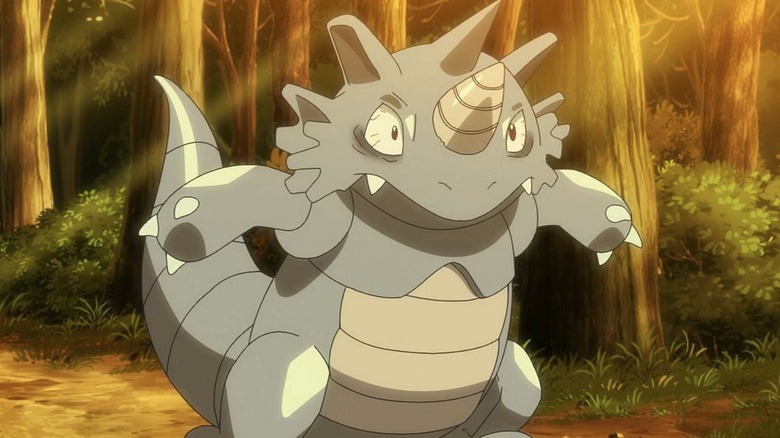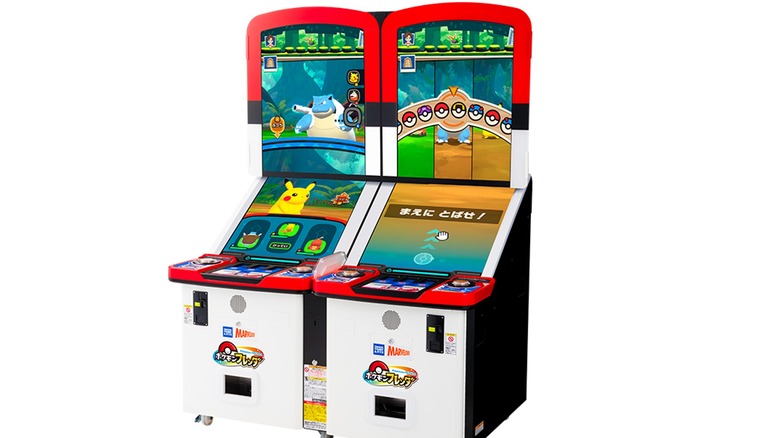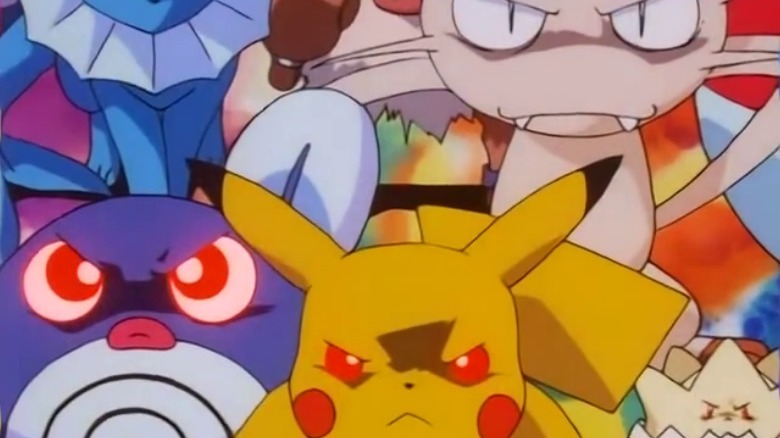The Only Way To Understand Pokemon Is To Know All The Facts
Gotta catch 'em all! The "Pokémon" series has been around for over 25 years, and in that time has had entries in nearly every form of media and entertainment. The video games have spanned multiple generations of systems, feature films have made millions, the anime and manga have told compelling stories, and the trading card game is still going strong. According to the Pokémon Company's sales figures, "Pokémon" is one of the most valuable franchises in the world.
That might not be all that surprising, but there's probably a lot that you didn't know about the "Pokémon" universe. Let's dive into some of the lesser known facts about this beloved franchise, and see what really makes Pikachu and the rest of the pocket monster crew tick.
Pokemon was inspired by the creator's love for bug catching
Even though he created one of the most popular video game franchises of all time, "Pokémon" creator Satoshi Tajiri does not quite have the name recognition of other superstar designers like Shigeru Miyamoto or Sid Meier. Despite his creativity, Tajiri has been described in publications like the Independent as "reclusive" and "eccentric." Like many creative people, Tajiri drew upon his childhood passions to create his most beloved works.
Tajiri grew up in Machida, Japan. Although the city has since been absorbed into the Tokyo metropolitan area, it was a mostly rural place in the 1960s. Tajiri grew up collecting insects in the area around his home, earning the nickname "Mr. Bug" from classmates and dreaming of becoming an entomologist. As the Japanese arcade scene grew in the '70s and '80s, Tajiri's bug obsession became a video game one, and he eventually purchased a Famicom so he could take it apart and learn how it worked.
The story is that, in 1990, Tajiri saw two people playing Game Boys connected by a link cable, and both of his childhood passions came together in a "eureka" moment. He envisioned a game that could allow people to collect their own virtual insects and pit them against one another. Six years later, the first "Pokémon" games were released, and the franchise began to take the world by storm.
Tajiri's verb philosophy
Long before he was the man who created "Pokémon," Satoshi Tajiri was a 16-year-old student who loved video games so much that he created a fanzine. It was called Game Freak, the name he would later give to his company. The first issue featured "Dig Dug" on the cover, complete with Tajiri's own pixel-by-pixel drawing. As an adult, he became a game developer himself, and brought a unique sensibility to the world of gaming. According to an interview he did with Japan's Game Center CX, he was thinking back to English classes in school and "Dig Dug" — which was, of course, based entirely around the act of digging — when he realized that you could build a game by starting with a single verb and working your way out from there.
The first example of this philosophy was "Quinty" (released in America as "Mendel Palace"), a game that was all about flipping over floor tiles to change their effects. Later, after he'd had some success developing the "Yoshi" puzzle game for Nintendo, he thought about a rare item in "Dragon Quest" that artist Ken Sugimori had two of, which made him wish he could trade things between games. With the verb "trade," the newly introduced Gameboy link cable, and his childhood interest in collecting bugs, the idea for "Pokémon" was born.
Pikachu wasn't always the mascot of the Pokemon series
Pikachu, Ash's first Pokémon, has become one of the most recognizable pop culture icons in the world. Outside of Japan, most people don't know that Pikachu was not even the original chosen mascot for the Pokémon series. That title belongs to "Pippi," who is known as Clefairy in English. In the book "Pikachu's Global Adventure: The Rise and Fall of Pokémon", author Joseph Tobin writes that, in the original manga adaptation of "Pokémon," Clefairy was Ash's first Pokémon. But the fairy-type had the ability to speak, and its crude sense of humor did not fly with the family-friendly dynamic Nintendo wanted from the "Pokémon" series. Rather than starting out with a Clefairy, Ash instead received Pikachu.
There were a few other reasons for the change from Clefairy to Pikachu. For one, Pikachu's more traditional design made it seem more like a pet a child might have than the strange design of Clefairy. Pikachu's bright yellow color also made it stand out more, as only Winnie the Pooh had a similar color scheme targeting the same demographic.
Pikachu's design wasn't based on the animal you think it was
The decision to make Pikachu the mascot of the Pokémon series catapulted the little electric mouse to fame, and Polygon suggests that Pikachu may actually overtake Mickey Mouse as the most recognizable icon in the world. Two mice battling it out for cultural dominance, and ... what? Pikachu isn't based on a mouse?
Yes, sorry to shatter your dreams, but Pikachu is actually based on a squirrel. Its design makes quite a bit more sense in that regard. Atsuko Nishida, who designed the character, spoke with Yomiuri about her inspiration: "At that time, I was really into squirrels, so I wanted the character to have puffy cheeks. Squirrel tails are cute, so I wanted it to have a tail. However, I wanted the character to have a lightning element, so I made it shaped like lightning ... Since I thought the ways squirrels moved were comical and cute, I wanted one." After Nishida submitted the design and it was named Pikachu, "Pokémon" creator Satoshi Tajiri actually made a few modifications, transforming it into the more recognizable electric rodent we know and love today.
The real pocket monster is ... Satan?
Like most things that gain massive popularity among kids — like "Star Wars," Harry Potter, and of course, "Dungeons & Dragons" — "Pokémon" drew its fair share of criticism from concerned and usually ill-informed adults. A lot of this was the standard stuff about how The Kids These Days were spending too much time on video games, but a lot of it was more about how people thought Pikachu was a tool of Satan designed to teach children how to summon and command evil forces.
The prime example of this comes from "Pokémon Power," a sermon that went viral when Everything Is Terrible released a highlight reel of a pastor explaining that Pokémon was actually teaching kids how to "take control of spirits in the Dark Realm," and forever bar their souls from Heaven. This viewpoint wasn't just limited to VHS tapes from the '90s, though, instead keeping pace with the continued popularity of the franchise. When Pokémon Go was released, a whole new wave of bizarre fundamentalist criticism was directed at the game, including a discussion from radio host Rick Wiles about how the "virtual cyber-demons" could lead "Islamic jihadists" to churches, rather than to, say, Bulbasaur. This is, of course, of primary concern, since before 2016, church locations were shrouded in the utmost secrecy.
One Pokemon episode hospitalized almost 700 children
"Pokémon" could hardly become the cultural sensation it has without its fair share of problems, and an early episode of the anime nearly rang the death knell for the franchise about a year after it got started. The now-infamous episode "Electric Soldier Porygon" sent hundreds of children to the hospital and knocked the anime off the air for over four months.
In the episode, Ash, Pikachu, and the rest of the crew enter a broken virtual world to try and fix it. When Pikachu uses its lightning to fend off the virtual defense mechanisms, the animators used a red and blue strobe effect to create the explosion. Children across Japan immediately began suffering from ailments: passing out, vomiting, nausea, and even some cases of seizures and temporary blindness. All told, 685 children were sent to the hospital due to "Pokémon shock," as the ailment was later called. The show was taken off the air for months to get to the bottom of the problem, and stocks plummeted due to the uncertainty of what was happening. The episode has never aired again, even in edited form, and Porygon has never appeared as a focal character on the anime since the incident.
The man who saved Pokemon
Even if you don't recognize Satoru Iwata's name, you're absolutely familiar with his work. As a developer, he was partially responsible for classics like "Super Smash Bros.," "Earthbound," and "Kirby's Dream Land," and as the president and CEO of Nintendo for 13 years, he was the public face of the company. Oh, and he's also the reason that we have Pokémon in America.
The initial plan for the original Pokémon games was to release them only in Japan, but after their massive success, Nintendo made the decision to localize them for the Western market. The problem was that Game Freak was already directing their resources toward "Pokémon Stadium" and the first mainline sequels, "Pokémon Gold" and "Silver." According to developer Tsunekazu Ishihara, they were ready to give up on the localization when Iwata stepped in and found a way to bring the first games overseas. And he didn't stop there: not only did he port the battle system to the N64 in a single week, he also helped with reprogramming "Gold" and "Silver." His data compression gave the developers enough space to fit the entire Kanto region, joining it with Johto and giving players a second quest.
Tragically, Iwata died in 2015 at the age of 55 due to cancer, but among the numerous tributes to his life and work, there's one hidden within "Pokémon Sun" and "Moon." If you visit the Alola offices of Game Freak, a programmer will tell you about an "amazing guy" who helped to "solve all of our problems" before becoming a company president.
The lies children tell
The "Pokémon" games are primarily directed at children, and if you've ever spent more than 15 minutes around a kid, you already know that they have a tendency to lie constantly. With video games, those lies would often take the form of impossible accomplishments or supposedly secret knowledge that could be handed down from fictional uncles who worked at Nintendo to get some instant cred on the playground. Rescuing Aeris in Final "Fantasy 7," Guile busting out a handgun in "Street Fighter 2" — these things spread around elementary schools like chicken pox.
With "Pokémon," the most common myths by far were the ones that said you could increase your chances of catching a wild Pokémon by hitting a button at exactly the right time (you can't, but it feels good to do it anyway), or involved Mew. Kids had become familiar with Mew thanks to "Pokémon: The First Movie," but outside of special events, it could not be caught in the game itself. Unless, of course, you figured out how to move the otherwise inexplicable truck that you could only get to by surfing past the SS Anne, that is. Mew's definitely under there. Our uncle said so, and he works at Nintendo.
Jynx, the problematic monster
Pokémon designs have taken their inspiration from plenty of different sources over the years, from the simple (a horse, but on fire) to the downright bizarre (what if an ice cream cone could fight?), but none have ever sparked the controversy that the franchise saw with Jynx.
As one of the original 151 monsters, Jynx made its debut in "Pokémon Red" and "Blue," where its vaguely human shape and a Pokédex entry about how it "seductively wiggles its hips as it walks" meant that it was starting as one of the weird ones. The real problem, though, came from its design. While Jynx may have been based on the yama-uba, a mountainous monster occasionally depicted with long white hair, the end result bore an unfortunate but undeniable resemblance to racist caricatures of black people. With that in place, Pokédex entries about Jynx's talent for rhythmic dancing and "incomprehensible" but human-like speech were easy to see as being rooted in offensive stereotypes.
When the franchise moved to the Game Boy Color, however, Nintendo made the decision to change Jynx's design to something a little less offensive. Rather than the black skin-tone that was mandated by the original Game Boy, the new version of Jynx was purple, and its depictions in the anime and official art were changed to match as well. The connotations of her original design are still there, but not quite as obvious as they were.
Team Rocket's got nothing on this
Whether it's a minor bit of shoplifting, kids snatching them up on the playground, or even a full-on smash-and-grab, there have been plenty of cases of Pokémon cards being stolen over the years. On one level, that's to be expected, since they're items that collectors will pay top dollar for that can also fit in the palm of your hand. In January of 2018, however, some thieves pulled off a Pokémon heist that puts Team Rocket to shame.
While trading card game stores in the United Kingdom were preparing for a pre-release event for the "Ultra Prism" expansion, a massive stock of brand new cards were stolen from the distributor before they even made it to stores. The result was that over 80 shops across the UK canceled their events, shutting down most of the country's Pokémon-related celebrations. All told, the thieves made out with an estimated $36,000 worth of merchandise, and that's just the retail value. While the affected stores would later restock, the Poké-thieves themselves have yet to be apprehended, and the actual details about the heist have yet to be released.
Cease and Desist, I choose you!
ROM hacks have been floating around since the rise of emulation in the '90s, but most of them are pretty straightforward. If you want to play a punishingly difficult Mario level, or a version of "Punch-Out!!!" where everyone's naked for some ungodly reason, they're out there. With some series, though, fans have taken ROM hacking to the next level and produced full, completely new games. "Pokémon" fans are no exception.
The most well-known fan-made Pokémon game is definitely "Pokémon Uranium," which was developed over the course of nine years and — according to its creators, at least — was downloaded over 1.5 million times. It introduced 150 brand-new fan-created Pokémon, including a new set of starters, and a new Nuclear type to go along with its radioactive themes. It was popular enough that its launch was considered news by tech sites, and needless to say, Nintendo's legal department took notice.
In 2016, Nintendo issued cease-and-desists to the creators of "Uranium," as well as other completed fan-made games like "Pokémon Prism." Unlike older "Mario" games, for example, "Pokémon" is still very much a going concern, and even virtual console releases of older titles are big news for fans. New creatures, new twists, and even revisiting older regions is a major selling point of the new games in the franchise, and Nintendo definitely doesn't want fans getting those things elsewhere.
Gold and Silver's prototype Pokemon
When they were originally released in 1999, "Pokémon Gold" and "Silver" were a huge expansion, bringing in a new region and 100 new Pokémon for trainers to catch. In 2018, however, plans have since leaked that revealed that there were originally plans for even more new monsters. In 1997, a playable demo of "Gold" was shown off at a trade show called Nintendo Space World, two years to the day before the final game was released to the public. It was early enough in the development cycle that the game didn't have music, and contained plenty of content that didn't make it to the final release.
Out of all the new content, the biggest surprise was the existence of unreleased Pokémon. The sequels introduced the idea of "baby Pokémon," giving younger forms to classics like Pikachu and Clefairy, but the game's code also included baby forms of Meowth, Goldeen, and Grimer, among others. There were also new evolutions for Ditto and Farfetch'd, and a completely different trio of starter Pokémon than the ones that ended up in the game, including a fiery teddy bear and a water type that bears a resemblance to Gen VII's Popplio. Needless to say, artists on Twitter took to drawing these unreleased Pokémon and as unlikely as it is, that kind of fan response could potentially lead to an official release someday.
There are over 100 Pokemon games
People who are out of touch with the "Pokémon" series might just assume it is a few games that have been added to over the years. Those a little more familiar might know that, every few years, a new "generation" starts, and new games come with it. "Pokémon" has done everything it can to saturate the game market, however, and there are probably a lot more "Pokémon" games out there than you realize. In fact, there are well over 100 different "Pokémon" gamesfor you to sink your teeth into!
The core games and spin-offs are fairly well known, but there is an eclectic selection of titles starring Pikachu and his friends. "Pokémon" puzzle games, "Pokémon" pinball, the "Mystery Dungeon" series, a "Learn how to type" game — the creatures are so iconic that they have been licensed and added to a huge number of titles across dozens of platforms. Chances are, if you want to play a game, there is a "Pokémon" version of it somewhere out there.
The world of Pokemon is based on real-world locations
"Pokémon" may seem like its fantastical world is drawn up from pure imagination, but the game designers actually based each generation's region on a specific area of the world. The first four generations, which include Red/Blue, Gold/Silver, Ruby/Sapphire, and Diamond/Pearl, are all based on different regions of Japan. Kanto, from the first generation, draws inspiration from Tokyo and its surrounding areas. Jhoto is based on Kansai, where historical cities like Nara and Kyoto are found. Hoenn is based on Kyushu. And the fourth generation's region, Sinnoh, draws inspiration from the northern Hokkaido area.
"Pokémon" continued to go strong after the fourth generation, so Game Freak needed to begin branching out of Japan for its in-game counterparts. Unova, from "Pokémon Black" and "White," is based off of New York City. The sixth generation's region, Kalos, is modeled after France and Great Britain; Kalos is full of gothic architecture and small cafes. The Alola region from "Pokémon Sun" and "Moon" is modeled after the a tropical Hawaiian paradise, while "Pokémon Sword" and "Shield" bases its Galar region on the UK. Not quite the same as going there in person, but it's nice that "Pokémon" takes us on a tour of some different parts of the world.
Pokemon Adventures is Tajiri-approved
"Pokémon" is one of the most popular media franchises in the world, so it shouldn't be surprising that the core idea has been presented to fans in a variety of different ways. There are the games and the anime, of course, which have been presenting slightly different takes on the Pokémon world for decades, but there are also plenty of offshoots.
If you're wondering which one bears the most compelling seal of approval, though, it's the "Pokémon Adventures" manga. As "Pokémon" creator Satoshi Tajiri explained, "This is the comic that most resembles the world I was trying to convey." While "Adventures" follows the events of the games rather than the anime, it also deals with some much darker elements than you'll find in Ash Ketchum's eternal childhood. Pokémon are shown to be more than capable of injuring and even killing humans, and the villains are much more violent, attempting to murder the characters rather than just steal their Pokémon. Giovanni even kills a Magmar by freezing it in ice and shattering its body. There's a higher price to being a trainer, too: Gym Leader Steven dies of exhaustion after trying to control three legendary Pokémon. You know, for the kids.
Crime and punishment in Pokemon Go
For many fans, the release of "Pokémon Go" provided a beautiful glimpse of a finer world, where you could encounter Charmander or Meowth on your way to work or at a local landmark, but it wasn't long before a few overzealous players found themselves in trouble. Several players were robbed while being distracted by an IRL Venomoth, stumbled off cliffs, or worse. One of them, though, used the game as an opportunity to break the law, and recorded the whole thing on video for his fans.
On August 11, 2016, Russian blogger Ruslan Sokolovsky decided to play Pokémon Go in the Church of All Saints in Yekaterinburg, Russia. The problem? Not only was this illegal, but according to Reuters, he did it specifically because he knew it had been outlawed beforehand. To make matters worse, he recorded it all for YouTube, including the parts where he cracked jokes like "I regret not catching the rarest of Pokémons: Jesus," which got him on the wrong side of a Russian law against "inciting religious hatred." Needless to say, the video was used as evidence, and Sokolovsky received three years' probation and 160 hours of community service for his premeditated Pokémon training. After being sentenced, Sokolovsky was asked if he planned to return to the game, and told reporters, "I won't play 'Pokémon,' it's already out of fashion."
Gold and Silver Were Supposed to be the Finale
Game Freak and Nintendo seem to announce a new "Pokémon" game every year. Nobody could have predicted just how popular the franchise would become; even its creators were preparing for the end before "Pokémon" turned into a perpetual money machine. During an Iwata Asks segment, the late president of Nintendo interviewed Tsunekazu Ishihara, CEO of The Pokémon Company, and Shigeki Morimoto, programmer and monster designer for the Pokémon games. During the conversation, Ishihara revealed that Game Freak went into "Pokémon Gold" and "Pokémon Silver" assuming they would be the "ultimate" entries in the franchise. And by ultimate, Ishihara meant last.
According to Ishihara, he believed that once "Pokémon Gold" and "Silver" were finished, Game Freak would move on to other, unrelated projects. He licensed as many products as he could to make sure the games were successful — except the anime. He was initially opposed to that idea but caved, and history demonstrated that the show was the right idea. In retrospect, many design choices in "Pokémon Gold" and "Silver" indicate Game Freak assumed the series would end up a fad and wanted it to go out with a bang. After all, the games culminate with players fighting the main character of "Pokémon Red," "Blue," and "Yellow." What better way to end a series?
Pokemon Was Almost Americanized in the Worst Way
What is the best way to make a game attract foreign audiences? Sometimes, all you need for a good translation is a language change, but other times, you need to localize a game to account for different societal standards, tastes, and wordplay. The "Pokémon" franchise is the face of this practice, and not just because American editors changed a healthy rice snack to sugary jelly-filled doughnuts. When the "Pokémon" games proved popular in Japan, Nintendo made the decision to export them overseas, and the company started with North America. Ever wonder why Japan received "Red" and "Green" versions while everywhere else got "Red" and "Blue"? Not only were these updated copies, but red and blue are two of the three colors of the US flag. That's marketing for you.
Another concern going into the American market was the titular Pokémon. According to Tsunekazu Ishihara, when Nintendo first showed them to US audiences, people thought they were "too cute." So to give the creatures a fighting chance in the US, Nintendo of America staff pitched their own replacement designs, most of which baffled Ishihara. One concept that stuck out to him was a revamped Pikachu, which he likened to "a character from the musical 'Cats'." Thankfully, Game Freak stood its ground and only let Nintendo of America change Pokémon names, not designs. Although, we kind of want to see these rejected redesigns if only for the sake of morbid curiosity.
Mewtwo Came Before Mew
For the most part, the origins of Pokémon species aren't important to the franchise. Save for content creator theorists, most audiences don't care why Garchomp looks like a bipedal shark; they only care if it is powerful in battle. Mewtwo was the exception, since its origin as a clone of another Pokémon, Mew, is integral to every aspect of its being. Originally, Mew was only meant to be supplemental Mewtwo material. An interview with Shigeki Morimoto (translated by DidYouKnowGaming) revealed that Game Freak never planned to insert Mew into "Pokémon Red" or "Green." The studio originally wanted to restrict the creature to lore and journal entries in order to build up Mewtwo. But when Game Freak discovered that Nintendo's debugging process had freed up 300 bytes, the studio decided, why not add Mew to the game?
Originally, Game Freak's illustrator and creature designer, Ken Sugimori, was supposed to draw Mew, but Morimoto ended up doing all the work. When he programmed Mew into the "Pokémon" games, everyone at Game Freak was in on the plan except for Nintendo. The publisher only learned about Mew when audiences started telling them about a glitch that let them catch a mysterious 151st Pokémon. According to Tsunekazu Ishihara, "Pokémon" games only sold decently at first, but once rumors about Mew and how to catch it started circulating, sales exploded. Had Game Freak not transformed Mew from an in-game legend to a tangible sprite, the "Pokémon" series might never have gotten past its first entry.
Taillow isn't Lazy, Just a Scrapped Idea
Most Pokémon look unique, but some fall into the same design tropes. For instance, it's hard to find a "Pokémon" game that doesn't start with a route littered with bird-like, Normal/Flying Pokémon. While it's easy to assume Game Freak is running out of ideas, turns out this pattern actually started with the company trying something new.
When Game Freak began working on the third generation of "Pokémon" games, they planned to make it a soft reboot of sorts. In a 2003 issue of Nintendo Dream Magazine (translated by Dr Lava), Ken Sugimori stated Game Freak wanted to populate "Pokémon Ruby" and "Sapphire" with only new Pokémon. But to make sure new gamers understood how Pokémon evolution worked, the company had to reuse old ideas. In other words, new Pokémon like Wurmple had to fill the same roles and functions as Caterpie, since caterpillar metamorphosis is an easy analogy for Pokémon evolution. The same applied to Pokémon like Taillow; despite only sporting two evolutionary forms, it had to fill the same niche as the Pidgey line.
Unfortunately, the best-laid plans of Minun and Mankey often go awry. In the same interview, Director Junihi Masuda stated that halfway through development, the team realized "Pokémon Ruby" and "Sapphire" suffered from balance issues. Specifically, the game lacked certain elemental types, so to fill in the gaps, the studio added Pokémon from older games. The remnants of the initial design are still visible in "Ruby" and "Sapphire," since players can't encounter legacy Pokémon until after the third city.
Lost and Invented in Translation
On the surface, translation and localization sound like straightforward processes, but it's as easy to produce an amazing translation as it is to unintentionally sabotage one. The first "Pokémon" games embody both extremes. Little-known fact about the "Pokémon" series: Every game up to "Pokémon Platinum" was translated by freelancer Nob Ogasawara. His work became the basis for the French, German, Italian, and Spanish language versions of "Red" and "Blue" (via DidYouKnowGaming). Nintendo wanted to use the Japanese names of Pokémon for the European market out of trademarking concerns, but French translator Julien Bardakoff told the company some Japanese Pokémon names are phonetically similar to French slurs. In return, Bardakoff got to create brand new names for the French versions of "Red" and "Blue" — and "Gold" and "Silver" — which he peppered with references to myths and legends. The German version followed with its own set of unique Pokémon names, but not all European countries were so lucky.
The Italian and Spanish versions of "Pokémon Red" and "Blue" are infamously shoddy. Not only do these titles use the English names of Pokémon, they are rife with mistranslations that defy linguistic logic. For instance, in the Spanish version, the attack "Slam" was translated as "Portazo" (to slam a door), while in the Italian version, the attack "Pound" was translated as "Libbra" (a measurement of weight). How could anyone make such mistakes? DidYouKnowGaming and Dr Lava interviewed the Italian localizer, Elana Fogozzaro, who claimed she was one of the first Italian translators Nintendo ever hired. More importantly, she was handed a list of words to translate without any context.
Influences Come Full Circle
"Pokémon" is so popular and has been around so long it was only a matter of time until a scientist played one of the games and named a discovery after their favorite Pokémon. In 2020 entomologists Yun Hsiao and Darren Pollock discovered three new species of beetles in Australia. Instead of naming the animals after themselves, the researchers drew from the "Pokémon" franchise's rarer creatures and named them Binburrum articuno, Binburrum zapdos, and Binburrum moltres. However, most discoveries named after Pokémon are more on the nose. For instance, in 2014, paleontologists examined fossils discovered in 1850 that scientists thought belonged to a species of pterodactyl. On closer examination, researchers realized it belonged to a unique genus and named it Aerodactylus scolopaciceps since, like its namesake Aerodactyl, the fossil looked like a hodgepodge of different pterosaurs. Oh, and we can't forget about Pikachurin, a retinal protein discovered in 2008 that was named after Pikachu.
Unfortunately, not every discovery that seemingly honors "Pokémon" actually does. In 2017, Dr. Christian Kammerer discovered a new genus of dicynodont (tusked mammal-like reptiles that predated dinosaurs) and dubbed it Bulbasaurus phylloxyorn. Many assumed Dr. Kammerer named it after Bulbasaur, especially because phylloxyron means "leaf razor," and the Bulbusaur line is synonymous with the attack Razor Leaf. In an email to Inverse, Dr. Kammerer set the record straight: He named the fossil for its prominently bulbous nose and its sharpened beak, which likely cut through plants like a razor. Still, the name is a very happy coincidence.
Pokemon Have Been Redesigned Under Your Nose
As previously stated, Jynx is one of the most controversial Pokémon out there. The creature initially sported coal-black skin, and Game Freak quickly changed its complexion to a less offensive purple. But while Jynx is the most famous example of Pokémon being redesigned, it is not the only one. If you examine the history of "Pokémon" art, you will notice Ken Sugimori's illustrations received a facelift for "Fire Red" and "Leaf Green." Before those games, he drew Pokémon using watercolor, but then he changed to digital art. He also subtly altered the designs of several Pokémon. For instance, Haunter, Golem, Raticate, Mr. Mime, and Pikachu originally had four fingers on each hand. From "FireRed"/"LeafGreen" and onwards, Haunter, Golem, and Raticate sported three fingers per hand, while Mr. Mime and Pikachu sprouted a fifth finger. Meanwhile, Zapdos and Dodrio originally walked around on three-toed feet, but as of "FireRed" and "LeafGreen," they now have four toes per foot.
These changes invite the question: What's so offensive about four fingers and three toes? DidYouKnowGaming might have the answer. In Japan, four-fingered cartoon characters are considered offensive to blue collar workers, such as butchers, who lost fingers. Alternatively, these Pokémon might have been changed for unintentional association with gangs. According to Pokebeach.com founder Jon Sahagian, a Pokémon Company employee told him parents thought Mr. Mime's four fingers referenced yakuza members since they also tend to lose fingers. As for Zapdos' and Dodrio's spontaneous new digits, DidYouKnowGaming theorized they were added for consistency since the other legendary birds, Articuno and Moltres, and Dodrio's pre-evolution Doduo, all have four toes.
Pokemon wouldn't exist without Shigeru Miyamoto
"Pokemon" is one of Nintendo's flagship series, and the franchise actually shares some DNA with another beloved Nintendo property. Shigeru Miyamoto is one of the best-known figures at Nintendo, but most people associate him with "The Legend of Zelda." Back in the 90s, though, Miyamoto played an integral role in creating "Pokemon." He worked as a producer on the very first game, but he was also very hands-on with the project. Miyamoto worked alongside Tsunekazu Ishihara, the current CEO of The Pokemon Company, for six years before the first "Pokemon" game debuted, refining the ideas that would become the core of the series.
Being so involved with the creation of "Pokemon," Miyamoto naturally became a huge fan of the series. He's still an avid player to this day, though his favorite game in the series is quite a bit different than the game he helped create more than twenty years ago. ComicBook.com reported that Miyamoto told a group of Nintendo shareholders at a 2021 meeting, "I'm currently hooked on 'Pokemon GO,'" revealing he and his wife had been playing the game for years. The couple even connected with some of their neighbors to take walks and capture Pokemon. In some ways, Miyamoto is the man who originally pulled strings to create "Pokemon," but in other ways, he's just a giant fanboy like the rest of us.
Fans still debate who the first Pokemon was
"Pokemon" fans have mapped out the entire history of the franchise, both in-game and in the real world. There are so many websites, wikis, and fan groups dedicated to "Pokemon" that you'd assume every basic fact about the series is all but written in stone. Actually, though, there are some questions about the series that fans just can't quite settle, and one of the biggest is the identity of the first Pokemon. Part of the problem here is that fans struggle to agree on a definition for "first." There's an argument to be made that Bulbasaur, Charmander, and Squirtle all simultaneously exist as the first Pokemon because they're the starters that players get to choose from in the first game. Real loreheads know that Arceus is a top contender for first Pokemon, because the games hint that the titular character may have been responsible for creating the entire world and all the Pokemon in it.
A third option that some fans argue for is the first Pokemon ever designed. When the original game's creators were making up their first round of creatures, they mostly drew dragon-inspired Pokemon. Rhydon, Pokemon number 112 in the original Pokedex, was the true first draft.
Westerners are still missing out on Pokemon games
Being slightly out of the loop is a fact of life for "Pokemon" fans who don't live in Japan. The series has become a global phenomenon, but the "Pokemon" games and shows that fans first fell in love with were all translations that Japanese fans had gotten to see first. For a while, games would debut in Japan before they'd make their way out into the rest of the world. Now "Pokemon" is big enough that everyone around the globe is more or less on the same schedule, but there are still some games Japanese fans have played that Westerners will likely never get their hands on.
If you haven't been to Japan, you might not realize just how popular arcade-style "Pokemon" games are. Nintendo has released well over a dozen different arcade machines featuring Pokemon-themed takes on all sorts of arcade classics, from simple fighting games to dancing games to lucky based gacha machines. "Pokemon" arcade games have been coming out since the mid 2000s, and Nintendo is still releasing new ones today. For the most part, the games are aimed at players who are so young they might struggle to get through one of the main "Pokemon" titles. Of course, some dedicated fans outside of Japan try to find arcade machines for their collection, but getting them in the West is anything but easy.
Viva la Pokerevolution!
The "Pokémon" anime is the punchline to countless jokes. The show's protagonist, Ash Ketchum, has been 10 years old for the past 25 years, and depending on how long the show lasts, he might remain that age for 25 more. But that was never the plan. The anime's driving force had every intention of ending Ash's adventure with a plot twist (or two) nobody would see coming. The main writer of the "Pokémon" anime was Takeshi Shudo. He wrote a ton of episodes, single-handedly penned the first movies, and even created Lugia. Shudo died in 2010, but a year prior, he wrote a blog that revealed some incredible things. Dr Lava hired a translator and discovered that the blog detailed Shudo's problems with alcoholism, how he created Lugia, and how he planned to end the "Pokémon" anime.
According to the translation, Shudo had two ideas for the "Pokémon" finale, the first of which would have taken place at the end of the first movie, "Mewtwo Strikes Back." In this hypothetical ending, Ash would have been an old man who looked back fondly on the good old days, remembering the friendships of his youth, especially with Pikachu. The next morning, he would have woken up a young boy again, ready to relive the best years of his life. Shudo's second proposal, meanwhile, was far more cynical. As he put it, this ending would have culminated in a Spartacus-styled rebellion of Pokémon vs. humans with Ash's Pikachu leading the charge. Of course, Shudo realized such an episode would break the show's established rules, so it's probably a good thing he never made it.

